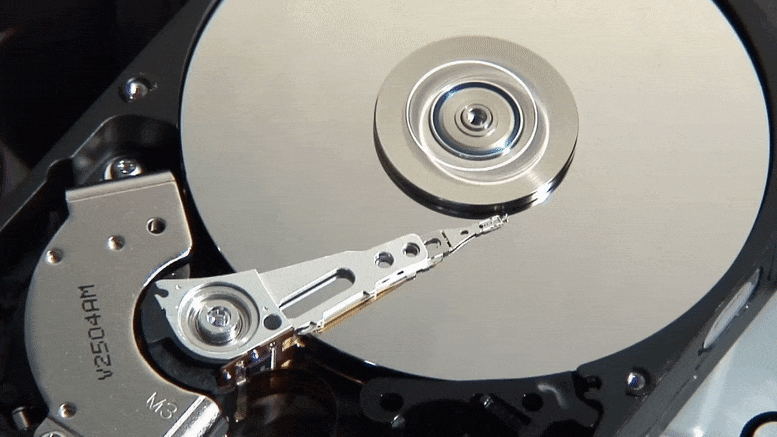
Posted on 06/11/2021 5:47:39 AM PDT by Red Badger

Graphene can be used for ultra-high density hard disk drives (HDD), with up to a tenfold jump compared to current technologies, researchers at the Cambridge Graphene Centre have shown.
The study, published in Nature Communications, was carried out in collaboration with teams at the University of Exeter, India, Switzerland, Singapore, and the US.
HDDs first appeared in the 1950s, but their use as storage devices in personal computers only took off from the mid-1980s. They have become ever smaller in size, and denser in terms of the number of stored bytes. While solid state drives are popular for mobile devices, HDDs continue to be used to store files in desktop computers, largely due to their favorable cost to produce and purchase.
HDDs contain two major components: platters and a head. Data are written on the platters using a magnetic head, which moves rapidly above them as they spin. The space between head and platter is continually decreasing to enable higher densities.
Currently, carbon-based overcoats (COCs) – layers used to protect platters from mechanical damages and corrosion – occupy a significant part of this spacing. The data density of HDDs has quadrupled since 1990, and the COC thickness has reduced from 12.5nm to around 3nm, which corresponds to one terabyte per square inch. Now, graphene has enabled researchers to multiply this by ten.
The Cambridge researchers have replaced commercial COCs with one to four layers of graphene, and tested friction, wear, corrosion, thermal stability, and lubricant compatibility. Beyond its unbeatable thinness, graphene fulfills all the ideal properties of an HDD overcoat in terms of corrosion protection, low friction, wear resistance, hardness, lubricant compatibility, and surface smoothness.
Graphene enables two-fold reduction in friction and provides better corrosion and wear than state-of-the-art solutions. In fact, one single graphene layer reduces corrosion by 2.5 times.
Cambridge scientists transferred graphene onto hard disks made of iron-platinum as the magnetic recording layer, and tested Heat-Assisted Magnetic Recording (HAMR) – a new technology that enables an increase in storage density by heating the recording layer to high temperatures. Current COCs do not perform at these high temperatures, but graphene does. Thus, graphene, coupled with HAMR, can outperform current HDDs, providing an unprecedented data density, higher than 10 terabytes per square inch.
“Demonstrating that graphene can serve as protective coating for conventional hard disk drives and that it is able to withstand HAMR conditions is a very important result. This will further push the development of novel high areal density hard disk drives,” said Dr Anna Ott from the Cambridge Graphene Centre, one of the co-authors of this study.
A jump in HDDs’ data density by a factor of ten and a significant reduction in wear rate are critical to achieving more sustainable and durable magnetic data recording. Graphene based technological developments are progressing along the right track towards a more sustainable world.
Professor Andrea C. Ferrari, Director of the Cambridge Graphene Centre, added: “This work showcases the excellent mechanical, corrosion and wear resistance properties of graphene for ultra-high storage density magnetic media. Considering that in 2020, around 1 billion terabytes of fresh HDD storage was produced, these results indicate a route for mass application of graphene in cutting-edge technologies.”
Reference: “Graphene overcoats for ultra-high storage density magnetic media” by N. Dwivedi, A. K. Ott, K. Sasikumar, C. Dou, R. J. Yeo, B. Narayanan, U. Sassi, D. De Fazio, G. Soavi, T. Dutta, O. Balci, S. Shinde, J. Zhang, A. K. Katiyar, P. S. Keatley, A. K. Srivastava, S. K. R. S. Sankaranarayanan, A. C. Ferrari and C. S. Bhatia, 17 May 2021, Nature Communications. DOI: 10.1038/s41467-021-22687-y
Windows 11 will need it for the OS..................
Any day now for the past 20 years: Batteries that will charge in minutes and hold 100x current capacities; dirt cheap solar panels; and new storage type that will hold a bazillion times more data.
In 2008, Matthieu Lamelot wrote a piece about Seagate drives:
With a width of less than a hundred nanometers and a thickness of about ten, the head flies above the platter at a speed of up to 15,000 RPM, at a height that’s the equivalent of 40 atoms.The head/platter operation is like a Boeing 747 flying over the surface of the earth at Mach 800 at less than one centimeter from the ground, while counting every blade of grass and “making fewer than 10 unrecoverable counting errors in an area equivalent to all of Ireland.”

This is the graphene ping list.
Click Private Reply below to join or leave this list.
Interesting: 10 Uses for Graphene.
NVMe
I wondered if anyone would catch the reference....it took awhile - thanks!
Wonders of Graphene
the Durham Report
QANON
The Kraken
“One BYTE = 8 BITS, so 8 Trillion BITS.”
Correct. I missed that.
Do these drives have multiple levels of data similiar to Blu Ray DVDs?
At that bit density wonder what the transfer rate is. And the track spacing.
Cost per bit of storage must be extremely low even now since so much is stored out there now. And all that byte-gobbling video stuff...
As storage and memory increased in the past new applications became possible e.g. Photos, music, videos.
I wonder what applications are on the horizon that would make use of increasing storage capacity?
I have to think it doesn’t stop with video. Something to do with VR?
AI.............................
I don't think so..................
I don't think so..................
I am impressed with the technology of mechanical hard drives these past few decades.
Considering the mass production of those things they represent serious precision engineering and manufacturing.
Data retention is serious business and those devices HAVE to always work or you are out of business.
I recently bought a Occulus Quest 2 VR headset.
From what i have noticed during my small time using it is if you want seriously good quality 360 degree video you need BIG TIME memory storage.
As long as you have good backups, you'll be OK. The biggest problem with SSDs IMO, is that too many of their failure modes is completely catastrophic and unrecoverable.
They are also too expensive for my purposes, except for the boot drive (where speed is most needed anyway). I still store my data on HDDs because they are much cheaper, and transfer rates isn't nearly as important for me.

Thanks to Red Badger for the ping!
The pr0n industry has been driving the advances in personal computer technology since the early 90's.
Seriously.
At least until TPTB determine that the info you are looking for is 'problematic' in some way.
What ever happened to those crystal cubes (around an inch square, I think) that they said was so promising more than a decade ago?
and honest wives........
Disclaimer: Opinions posted on Free Republic are those of the individual posters and do not necessarily represent the opinion of Free Republic or its management. All materials posted herein are protected by copyright law and the exemption for fair use of copyrighted works.